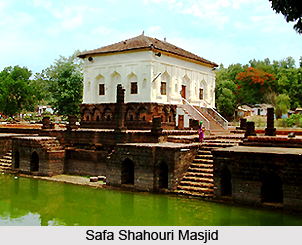 Safa Masjid or the Shifa Shahourie Masjid is a prominent Islamic shrine located in Shahpur, Ponda in the North Goa district. This Islamic ecclesiastical structure is a historian`s delight. The mosque is considered as an important heritage monument of Goa. The Safa Masjid is a very relevant representative of the history and culture of medieval Goa.
Safa Masjid or the Shifa Shahourie Masjid is a prominent Islamic shrine located in Shahpur, Ponda in the North Goa district. This Islamic ecclesiastical structure is a historian`s delight. The mosque is considered as an important heritage monument of Goa. The Safa Masjid is a very relevant representative of the history and culture of medieval Goa.
`Safa` is an Arabic word which means clean, chaste and pure. The mosque bears a resemblance to the word appropriately. From 1489 Goa remained under the rule of the Adilshahi rulers of the Bijapur Kingdom. The mosque is said to have been built by Ibrahim Adilshah. The Safa mosque has survived the destruction caused by the Portuguese colonizers as part of the Inquisition process. It was during the reign of the Bijapur Sultan that the region witnessed a proliferation of mosques and Ponda alone was home to 27 of them.
Ponda was later annexed by the Portuguese during the mid of the18th century. The ruins of the mosque vividly recapitulate its past glory. The most appealing part of the Safa Masjid complex is the well-constructed masonry tank with 44 `hammams` (hot air baths) on its four, interior sides. The tank is located to the south of the prayer hall unlike most mosques which are generally located outside the main entrance. The structure boasts of the typical Islamic Mehrab designs. The tank also has a flight of steps that resemble the typically Hindu bathing `ghats` style. This green rectangular tank acts as a mirror to the small mosque which stands elegantly facing it. The tank and the mosque are built up of laterite masonry stone. There were small niches for devotees to pray. The relics of the mehrab designs are still visible on all the four sides of the mosque. The upper half of the mosque is plastered with a cream colour in chhajja (eaves) design. The `mehrab` double arches are decorated with gorgeous lotus bud motif on the top half of the mosque. This gives a touch of splendour to the beauty of this simple mosque. Here the mehrab style windows are square in shape. The rectangular shaped prayer hall of the mosque rests above a high base and is capped with a pointed terracotta designed tile roof.
The Safa Masjid is thus a fusion of Indo-Islamic style. The mosque and the tank were formally bordered by a lush garden with many fountains. The two main festivals Id-Ul-Fitr and Id-Ul-Zuha are celebrated at this mosque with great solemnity and are attended by a large number of devotees.



















